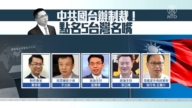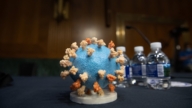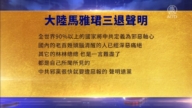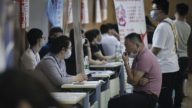【新唐人2012年9月4日訊】最近,有消息指稱,多年前被中共國家發改委批示,一律暫停的煤製油項目,有死灰復燃的跡象。業內人士估計,待審批金額可能達到7000億人民幣。過去煤化工業在大陸的過渡發展,對環境污染、水資源的浪費早已備受爭議。輿論認為,這是當局又一次為地方財政收入、拉臺GDP的短視作為。
2008年9月,中共國家發改委發佈的《關於加強煤製油專案管理有關問題的通知》中,明確要求各地區加強煤製油專案的管理。當時,除了「神華集團」的兩大煤製油專案外,一律停止實施其他煤製油專案。目前,這則通知在網頁上已被刪除,但網上仍留有不少相關報導。
另外,中共國務院辦公廳在隔年5月發佈的《石化產業調整和振興規劃》中,對煤化工技術和專案准入方面規定「禁止核准或備案;按照有關規定嚴格實行核准制」。
不過,最近內蒙古「伊泰煤炭公司」總經理葛耀勇向《中國經營報》透露,目前,中共國家發改委等相關部門,正在審批「伊泰」投資建設的200萬噸煤製油專案,預計將很快獲得審批。報導還說,在內蒙古、新疆等多個省區,共計金額可能達到7000億人民幣的新型煤化工專案,也在等待評審。
四川高級工程師範曉認為,除必需考慮環境容量問題之外,中國還存在這些大項目的投入並非以實際需求來考量;更多原因是地方當局從中獲得短期的利益,包括稅收、GDP、拉動地方財政收入。
四川高級工程師範曉:「包括煤電規模,不光是煤電,現在很多基礎設施,基礎的能源的投資,它是不是需要這麼大的規模,這本身就是有疑問的。就是,在最近的十幾年,包括未來的十幾年或者幾十年,整個能源投資預期的,未來增長的提供能源的規模,現在提供的這些能源建設項目,它是遠遠超過實際的需求的。」
據了解,傳統煤化工存在能耗高、污染重、規模小、工藝技術落後問題,在「十一五」期間就產能全面過剩。而新型煤化工由於耗水嚴重,導致原本「多煤少水」的西部面臨更嚴重的水危機。
美國「南卡羅萊納大學」教授謝田:「這個項目它有很多問題,首先,它要大量的政府補貼;但是,這項目本身如果耗水耗得那麼高,技術又不成熟,很可能就是一種巨大的浪費,投入太高的話,實際上就沒辦法真正的商業化,可能就永遠收不回來成本,又變成巨大的財務窟窿。我覺得是,中國經濟下行、經濟停滯給政府帶來的壓力太大了。實際上,現在有點飢不擇食,找到這種項目,就開始要匆促的草率的上馬。」
報導中,「上海華然投資諮詢公司」研究員趙辰介紹,從綜合行業的平均水準觀察,目前生產一噸煤製油的耗水量約為9噸﹔煤製烯烴約為20噸﹔煤製二甲釄約為12噸。如此看來,煤化工的高耗水是最大的隱憂和軟肋。
範曉:「實際,這個水資源是不能滿足的,那麼,必然會影響整個水資源供應的危機。反過來對水,對大氣環境也會產生污染。從經濟方面它也是有隱患的,因為,能源也會受到市場波動的影響。就以煤炭來說,最近一年多煤炭的價格下跌的非常厲害,從長遠來看肯定會有很沉重的經濟負擔在裏面。」
汚
目前,多家煤化工項目都將水源盯住了黃河。國際環保組織綠色和平、「中國科學院地理科學與資源研究所」8月14號聯合發佈的研究報告中說,「十二五」期間計劃在山西、陝北、內蒙、新疆、河南、雲貴等地,打造煤電一體化開發建設的16個西部大型煤電基地,每天用掉的水,將是北京城區日供水能力的9倍。
這些正待審批的項目已受到中國各界人士的關注。民間環保人士陳雲飛指出,這又是一個未經民意,沒有徵詢真正專家評估;各地當局利益團體瓜分資源的一次組合。而事實上,有目共睹的是,自從中共統治大陸至今,搞了多少這類的專案,帶來不計後果的環境污染問題。
採訪編輯/梁欣 後製/李月
Suspended Coal-to-Chemical Projects in China Comes Back
China has reportedly seen a revival of
Coal-to-liquids (CTL) projects,
which were suspended many years ago
by the Chinese Communist Party (CCP) regime.
Industry insiders estimate the projects awaiting
approval may involve RMB 700 Billion.
Excessive development of China’s coal chemical industry
has long been controversial for its pollution and water waste.
Commentators say it is another shortsighted action taken
by local authorities for fiscal revenue and pull GDP figure.
On September 2008, the CCP’s National Development
and Reform Commission (NDRC) issued a notice.
The notice strengthened regulation of CTL projects.
The regime ordered all CTL projects to stop
in China, except the two under Shenhua Group.
The notice has now been removed from the webpage,
but lots of related news reports are still accessible online.
In May 2009, the General Office of the CCP’s State Council
released a plan to restructure the petrochemical industry.
The plan stated, “prohibit the approval or filing” of
market access for coal-to-chemical technology and projects.
Recently, China Business Journal reported news about
the coal liquefaction project of Inner Mongolia Yitai Group.
Yitai’s 2-million-ton CTL project is reportedly waiting NDRC
approval, and is expected to get the green light soon.
The news said there are coal-to-chemical projects awaiting
approval that involve investment of RMB 700 Billion.
These neo-type projects are located
in Inner Mongolia, Xinjiang and other regions.
Sichuan-based senior engineer Fan Xiao says that
environmental capacity is a must factor to be considered.
Fan Xiao comments that the CCP regime approving such
large projects is not based on the actual demand.
Short-term interests that can benefit local authorities are
the main reason behind the approval, said Fan Xiao.
These benefits include tax, GDP,
local fiscal revenues, etc.
Fan Xiao: “A lot of existing basic resource projects, like coal
and power, has been brought into question in large scale.
In the next decade or so, China’s investment
in energy has far exceeded its needs, in reality.”
Traditional coal-to-chemical projects are known
as high energy consumption, heavy pollution, small scale and obsolete technologies.
Back in the period of 2006-2010, China had
excess capacity in the coal-to-chemical industry.
The late-model coal-to-chemical
projects have high use of water.
This caused a more serious water crisis in Western China,
where there are abundant coal deposits but lack of water.
Xie Tian, Professor, University of South Carolina:
“This project shows a lot of problems.
Firstly, it’s greatly subsidized by the government, and
has such high water usage and immature technology.
If it is invested in heavily, it’s very likely to be a huge waste.
So it cannot really be commercialized, and would probably
never cover its cost. That would be a huge financial hole.
In my view, China’s economic downturn and stagnation
has put too much pressure on the regime.
Now it’s not choosy about its food. Once the project
looks favorable, it will rush hastily to launch it.”
A research fellow at a Shanghai-based investment
consulting firm revealed data to the China Business Journal.
On average, the production of 1 ton
of CTL uses about 9 tons of water.
1 ton of coal to olefins needs about 20 tons of water.
1 ton of the coal-based dimethyl
ether uses some 12 tons of water.
High water usage is coal-to-chemical
industry’s biggest problem.
Fan Xiao: “There is no infinite supply of water resources.
That’s bound to cause a water supply crisis.
In return, it pollutes water resources
and the atmospheric environment.
It also poses potential risks for the economy,
as energy can be easily affected by market fluctuation.
For example, the price of coal
has slumped in the last one year.
So in the long run, heavy financial cost
will be hidden inside these projects."
A number of coal-to-chemical projects have
pegged the Yellow River as their water source.
A joint research report was released on August 14
by Greenpeace International and the Institute
of Geographic Sciences and Natural Resources
Research, Chinese Academy of Sciences.
It states that in China’s official “12th Five-Year Plan",
16 large coal power stations are to be constructed.
They will be located in Western China, with the daily
use of water at nine times the supply capacity in Beijing.
The projects awaiting official approval
have aroused public concerns in China.
Environmental activist Chen Yunfei remarked
that these projects form “another portfolio”.
It is “another portfolio” without seeking
public opinion, nor real expert assessment.
It is “another portfolio” that is divided up among local
authorities and interest groups, said Chen Yunfei.
In reality, since the CCP took rule of China,
the country has existed in the pollution caused by so many of these kinds of project.





























